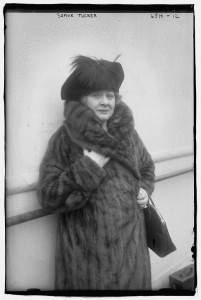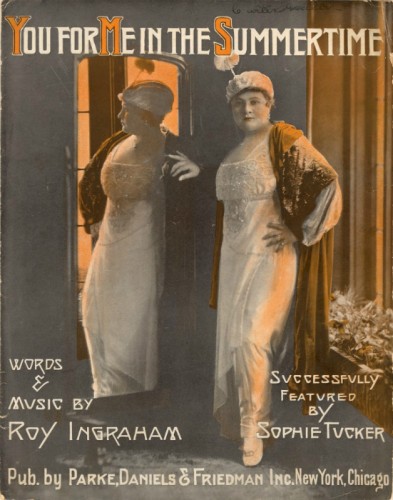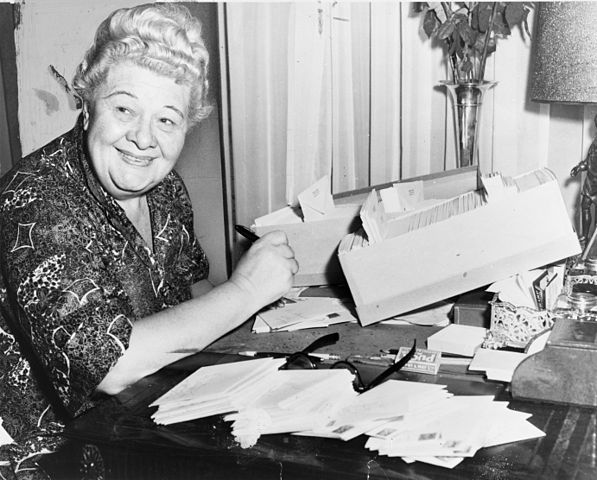By Jeannine Henderson-Shifflett
Brash, bold and her own woman, Hartford’s Sophie Tucker enjoyed a long and successful career as an entertainer, performing for almost 60 years. Nicknamed “the Last of the Red-hot Mamas,” she was an inspiration to both the entertainment and the Jewish communities, maintaining her faith throughout her life and donating money to various charities, including the Jewish War Relief Campaign.

Sophie Tucker – Library of Congress, Prints and Photographs Division
Born in Russia in 1884, Sophie Kalish and her family immigrated to the United States and by the time she was eight had moved to Hartford, where they opened a Jewish restaurant on Front Street called Abuza’s Home Restaurant. Little Sophie often entertained the restaurant’s customers with her singing and enjoyed performing so much that she soon moved on to amateur singing contests. Audience members often shouted, “Give us the fat girl!” Sophie would jump up and perform, never worried about her size or looks. She later said she wanted to put on a show that the audience would remember.
She continued to perform until her first marriage at 16, and although she and her husband Louis Tuck had one son, the marriage quickly fell apart. Leaving her young son at home, Sophie moved to New York where she attempted a career as an entertainer. Upon her arrival, she wrote to her mother and explained her decision, promising to send money for the care of her young son.
She changed her name to Sophie Tucker, which she thought sounded like a good name for a singer, and got a job at the German Village beer garden earning $15 a week. Her first big break came in 1907 at Chris Brown’s amateur night. The manager felt she was too big and unattractive to sing as herself so he had her go on stage in blackface, a popular practice in the early 20th century. She reluctantly accepted, performed, and quickly became a success as a “World Renowned Coon Shouter,” for which she earned $25 a week. Tucker performed for four years in blackface and hated it, feeling such shame that when she toured her act in Meriden, Connecticut, she didn’t tell her family. Shortly after, when her makeup failed to arrive for a big show in Boston, she won the audience over as herself and never performed in blackface again.

“You for me in the summertime”, sheet music featuring Sophie Tucker, 1915 – Rare Book, Manuscript, and Special Collections Library, Duke University
In 1909, Tucker got a part in the Ziegfeld Follies, one of the biggest acts of the time, but the other performers envied her and she lost her voice due to stress. Her luck changed when she caught the eye of William Morris, a talent agent who quickly signed her and put her to work. Her new act included tunes, such as “Nobody Loves a Fat Girl but Oh How a Fat Girl Can Love,” which became known as Sophie’s “Red-hot Mama” songs. In 1911, songwriter Shelton Brooks offered her a song called “Some of These Days.” Hugely popular, it became Tucker’s signature piece, one she included in her act for the next 30 years.
In 1913, Tucker returned to Hartford to perform at Poli’s Vaudeville Theatre, the same theater she visited as a girl, only now the billboards announced, “Sophie Tucker, The Pride of Hartford.” A huge success in her hometown, she would later say that the week she spent in Hartford was one of the best in her life.
In 1922 Sophie toured England with Ted Shapiro, her new pianist. The duo worked well and would perform together for the rest of her career. Later, she branched into movies, television, and radio but complained about the censorship, remarking in an interview, “I couldn’t even say hell or damn and nothing, honey, is more expressive than the way I say hell or damn.”
Still, between 1929 and 1945, she made eight films, including 1938’s Broadway Melody in which she played the mother to Judy Garland’s 15-year-old singer. In 1938, she became the first woman to chair the American Federation of Actors. Sophie continued appearing in nightclubs using her classic sexy act, updating it as she got older and singing songs such as “I Am Having More Fun Since I Am Sixty.” She continued to perform until her death from lung cancer in 1966. An estimated 3,000 mourners attended her funeral service at Emanuel Synagogue in Wethersfield. She is buried in the synagogue’s cemetery.
Jeannine Henderson-Shifflett, whose work includes curating several exhibits at the New Britain Youth Museum and researching and writing a walking tour for Connecticut Landmarks, holds a graduate degree in Public History from Central Connecticut State University.








